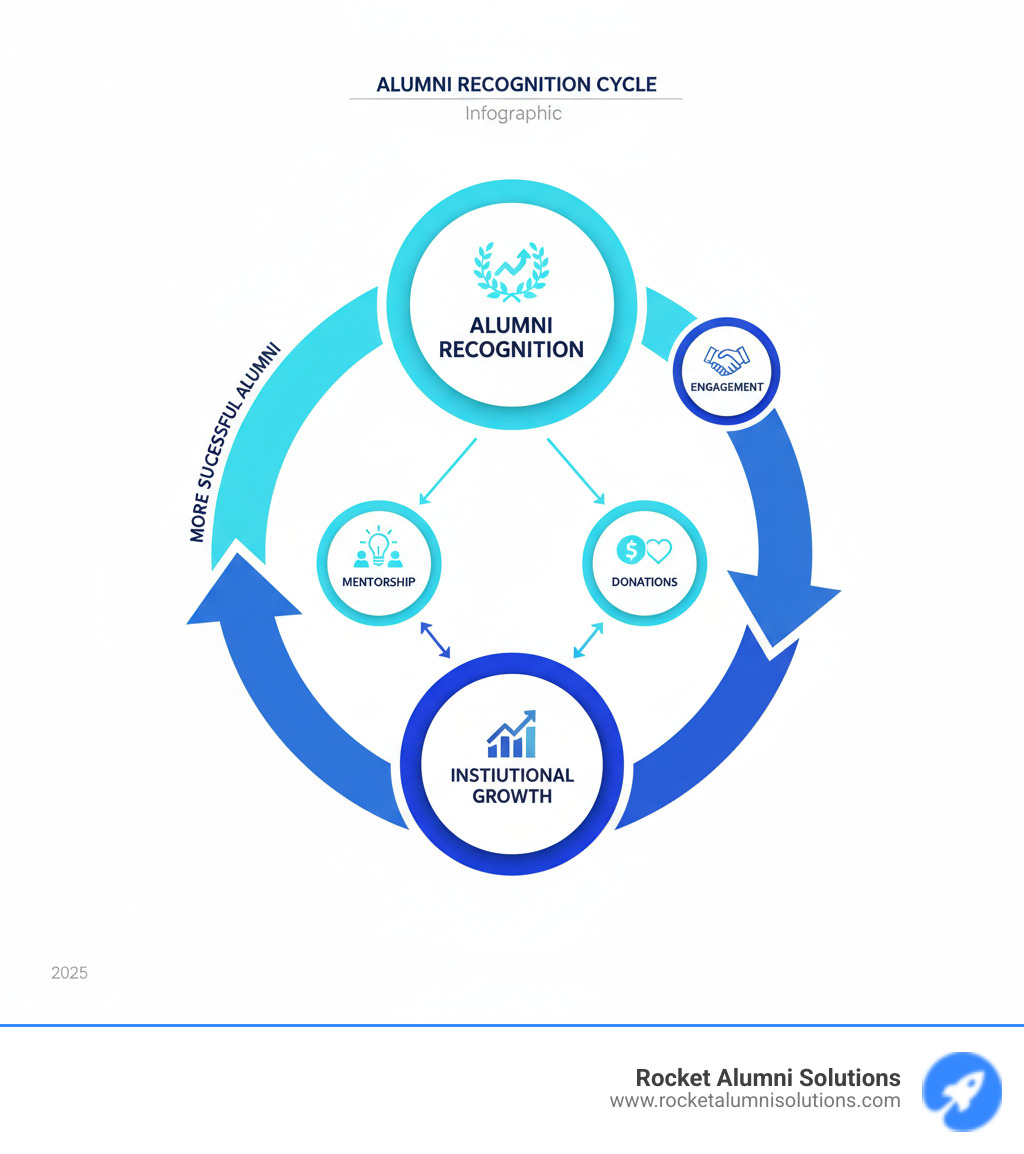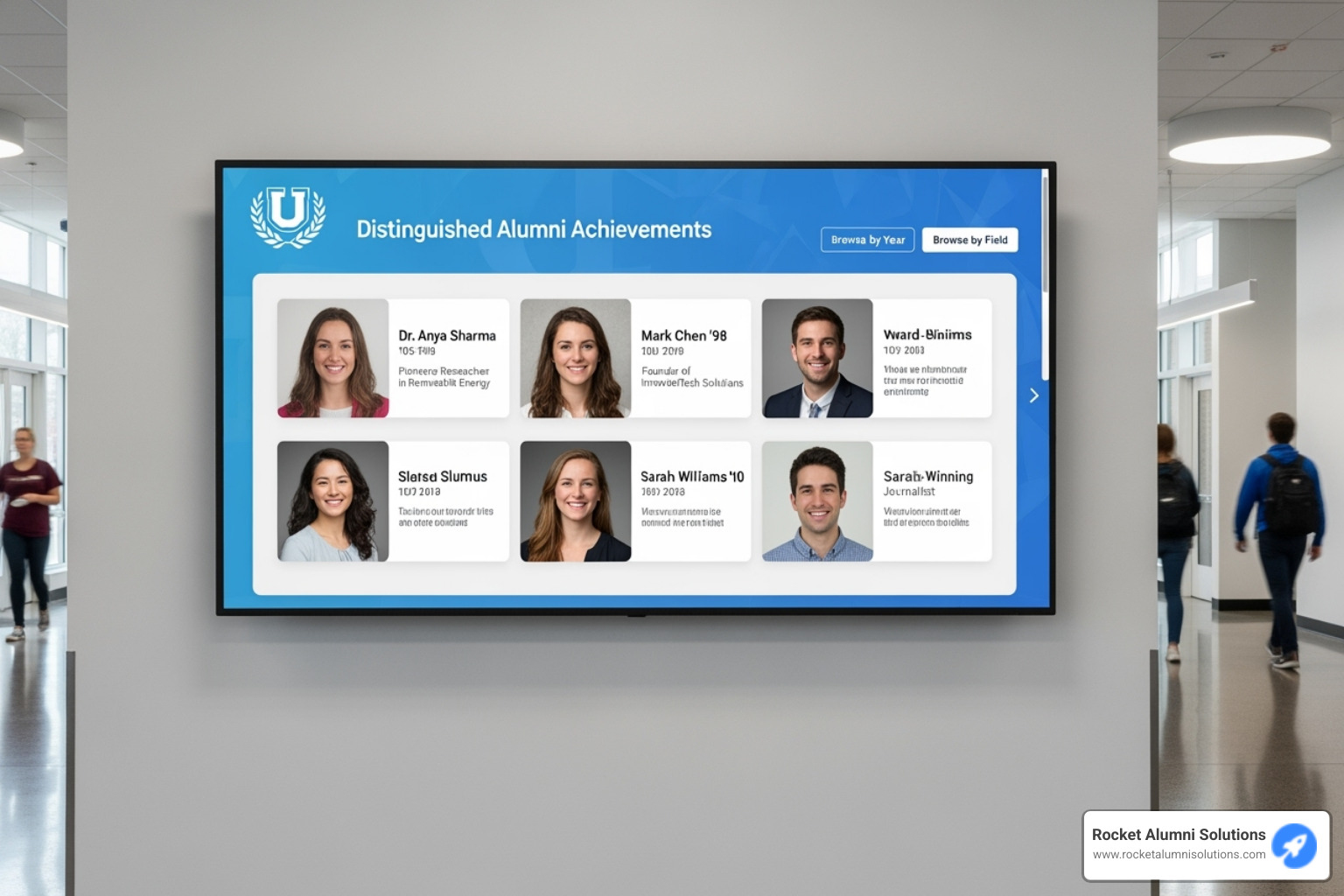Why Alumni Recognition Matters More Than Ever
Alumni Recognition is a strategic way institutions honor graduates for professional success, community leadership, or contributions to their alma mater. The most common forms include:
- Distinguished Alumni Awards - Honoring lifetime achievement and professional excellence
- Young Alumni/Rising Star Awards - Celebrating early-career success (typically under 40)
- Community Service Awards - Recognizing volunteerism and public service
- Athletic Halls of Fame - Preserving sports legacies and team achievements
- Innovation & Entrepreneurship Awards - Highlighting founders and industry changers
Alumni recognition programs serve multiple purposes. They foster pride within the community, inspire current students by showcasing what's possible, and strengthen the bond between alumni and their alma mater. Robust recognition programs often see increased donor engagement, as alumni who feel genuinely valued are more likely to stay connected.
These programs also create a cycle of giving back. Recognized alumni often become mentors, advocates, and financial supporters. As one recognized founder noted, "Being recognized by the community that set me on my path is both humbling and deeply meaningful." This connection transforms passive graduates into active participants in their school's future.
I'm Chase McKee, Founder & CEO of Rocket Alumni Solutions, and I've helped hundreds of institutions modernize their Alumni Recognition programs with interactive digital displays that celebrate achievements while driving engagement. My experience has taught me that effective recognition isn't just about awards—it's about creating visible, ongoing connections between past success and future potential.

Foundational Award Categories
1. The Classic "Distinguished Alumni Award"
The Distinguished Alumni Award is the peak of Alumni Recognition, honoring individuals who have reached extraordinary heights in their careers, communities, or through philanthropy over a lifetime. The common thread is exceptional impact.
What makes someone worthy of this highest honor? The RIT Awards and Recognition program honors those who "have brought distinction at the highest levels... through professional, community, or philanthropic achievements." Similarly, The Ohio State University's Alumni Medalist Award recognizes alumni who have "gained national or international distinction in their chosen field" and brought "extraordinary credit to the university."
These awards are about embodying institutional values. Purdue University's College of Science celebrates alumni whose "work and achievements have made a significant difference... embodying the college's mission and serving as inspirational role models."
Presenting this award tells current students: "This graduate walked these same halls and went on to change the world." It's powerful motivation.
2. The "Young Alumni" or "Rising Star" Award
The "Young Alumni" or "Rising Star" award celebrates graduates making a significant impact early in their careers, often before age 40. This category proves Alumni Recognition isn't just for lifetime achievement.
These awards spotlight emerging leaders who are making waves right now. Most institutions target alumni under 35 or 40. Crescent School's "Young Alumni Excellence Award" acknowledges that achievement looks different at various career stages.
Mississippi State University's "The Reveille 25" program honors "25 high achieving, young alumni who are 'answering the call' of the university's mission for excellence..." The name thoughtfully bridges tradition and innovation.
The Ohio State University's William Oxley Thompson Alumni Award targets "young alumni (under 36) who have demonstrated notable achievement through a career, civic involvement, or both." Recognizing these rising stars celebrates current success while nurturing future engagement, as today's rising star often becomes tomorrow's major donor.
The "Community Service & Leadership" award recognizes alumni dedicated to improving the world through volunteerism, public service, and non-profit work. It honors graduates who make their communities better.

This award celebrates loyalty, dedication, and generosity that creates positive change. The University of Toronto's Arbor Awards recognize "alumni volunteers whose loyalty, dedication and generosity has made a positive mark at the University of Toronto." Crescent School's "Alumni Community Leadership Award" honors "tremendous volunteer service to Crescent School."
The Ohio State University's Robert M. Duncan Alumni Citizenship Award goes to "alumni who have distinguished themselves through service to humanity... performing significant voluntary service beyond professional duty." These recipients prove that education is about becoming someone who makes a difference.
Honoring community service through Alumni Recognition strengthens your institution's reputation for producing civic-minded leaders, inspires students, and encourages other alumni to give back, creating a ripple effect of positive impact.
Celebrating Specific Achievements
4. The Athletic Hall of Fame
For institutions with a rich sports tradition, an Athletic Hall of Fame is more than nostalgia; it's a living connection between yesterday's heroes and tomorrow's champions. It preserves moments of triumph and reminds students that greatness walked the same halls.
Preserving Sporting Legacies: An Athletic Hall of Fame celebrates the athletes, coaches, and teams that built your institution's athletic reputation. RIT's Sports Hall of Fame honors "former athletes, coaches, teams, and administrators for their contributions to RIT intercollegiate athletics." Western University's Mustangs Sports Hall of Fame creates a similar permanent tribute.
Minneapolis Roosevelt High School's Athlete Hall of Fame celebrates "notable Teddy athletes spanning the last 100 years..." These displays feature stats, game moments, and bios that bring history to life for current student-athletes.
When a freshman athlete sees a photo of a past championship team, it connects past glory with present ambition. That's the power of athletic Alumni Recognition—it shows students they're part of something bigger.

5. The "Innovation & Entrepreneurship" Award
The "Innovation & Entrepreneurship" award celebrates bold graduates who forge their own paths, look at the world, and decide to make it better. It recognizes the risk-takers, problem-solvers, and visionaries.
Highlighting Modern Success Stories: This award is for the alumna who launched a game-changing startup or the graduate who developed a widely used app. The Schulich School of Business honors "founders of innovative, industry-changing businesses." Purdue University's College of Science offers an "Alumni Entrepreneur" award celebrating "achievement and creativity in entrepreneurship."
George Brown College offers both an "Alumni Entrepreneur Award" and an "Alumni Innovation Award," acknowledging that innovation can happen anywhere, from building a company to revolutionizing processes within one.
These awards send a clear message to students: your education is about creating possibilities. Seeing that their school produced a founder of a company they use shifts their mindset from "What job will I get?" to "What problem will I solve?"
Traditional plaques are static and don't tell the full story. Digital Alumni Recognition displays change everything by offering a dynamic, engaging alternative.
Engaging with Technology: Imagine a sleek touchscreen where visitors explore alumni achievements through video interviews and interactive timelines. Digital displays transform recognition from a passing glance into an engaging experience. Brighton High School's digital hall of fame includes "yearbook digitization from the 1950s to 2023," making decades of history searchable and alive.
Digital displays are versatile, showcasing athletes, academics, and entrepreneurs in one platform. You can feature game footage, event calendars, or campus wayfinding. A visitor can watch an alumnus's video bio, then get directions to the awards ceremony.
The practical benefits are huge. Content can be updated from anywhere via a cloud-based portal, eliminating the need for expensive service calls or waiting for new plaques. This flexibility allows you to add new inductees or feature different alumni with ease.

Digital displays also improve accessibility. Modern solutions are ADA compliant and can integrate social media feeds, making it easy for alumni to share their recognition. By showcasing achievements on mobile devices, you extend recognition beyond campus walls, allowing alumni to share their profiles with their networks.
This isn't just about looking modern. It's about creating recognition that drives engagement, inspires students with dynamic content, and builds a visible connection between past success and future potential.
Building a Comprehensive Alumni Recognition Program
7. Mentorship Program Recognition
When we think about Alumni Recognition, it's easy to focus solely on career achievements or community service awards. But some of the most meaningful contributions alumni make don't come with headlines or accolades—they come in the form of time, wisdom, and guidance shared with the next generation.
Strengthening the Alumni-Student Bond: Alumni who participate in mentorship programs are giving something far more valuable than money—they're giving their experience, their network, and their encouragement to students who are just starting their journeys. These mentors provide career guidance, open doors to networking opportunities, and offer real-world insights that can't be found in any textbook.
George Brown College understands this beautifully with their "Alumni Mentor Award," which celebrates graduates who dedicate their time to guiding students and recent graduates. As one George Brown graduate put it, "mentoring is a rewarding way to give back not only to the college but also to the marketing industry as a whole by supporting our next generation of talent." That sentiment captures exactly why recognizing mentors matters—it acknowledges their commitment and inspires others to step up and do the same.
The University of Toronto takes an interesting approach with their OISEAA Doctoral Fellowship, which "recognizes and supports doctoral students who volunteer with our alumni." This creates a beautiful cycle where engagement flows in both directions, with students and alumni learning from each other.
By formally recognizing mentors through awards or special recognition events, institutions send a clear message: giving back your time and wisdom is just as valuable as any financial donation. This strengthens the entire alumni network and creates a culture where experienced graduates naturally want to help those following in their footsteps.
8. A "Wall of Honour" or Legacy Project
Some achievements deserve more than a certificate or a mention in a newsletter—they deserve a permanent place in the institution's history. That's where a "Wall of Honour" or legacy project comes in, offering the highest form of Alumni Recognition an institution can bestow.
Highest Forms of Recognition: A Wall of Honour isn't just another display—it's a statement. It tells visitors, students, and future alumni: "These are the people who represent the very best of what we stand for." Crescent School, for example, features their "Wall of Honour" as their "highest honour for Crescent School alumni," reserved for those whose contributions have been truly extraordinary.
These legacy projects can take many forms. A physical wall in a prominent hallway creates a daily reminder of excellence as students walk past it on their way to class. A sophisticated digital display can bring these stories to life with video tributes, interactive timelines, and searchable content that makes decades of history accessible at the touch of a screen.
Many institutions also use these spaces for donor recognition, acknowledging the philanthropic contributions that make programs, scholarships, and facilities possible. Whether physical or digital, these walls tell the ongoing story of an institution through the lives of its most impactful graduates. They preserve legacies for generations to come and serve as constant sources of inspiration.
When a student sees a Wall of Honour and thinks, "I want to make a difference like that someday," the installation has done its job. It's not just looking backward—it's inspiring forward momentum.
Even the most thoughtful Alumni Recognition program will fall flat if people don't trust the selection process. That's why establishing a fair, transparent, and well-communicated nomination process is absolutely essential.
Ensuring Fairness and Transparency: Think of the nomination process as the foundation of your entire awards program. Without it, even the most deserving candidates might be overlooked, and the community might question whether the right people are being honored.
A solid nomination process starts with clear eligibility criteria for each award category. George Brown College, for instance, specifies that "Awards are open to all graduates of George Brown College," and makes it clear that anyone can nominate a candidate—not just faculty or staff. This openness encourages broader participation.
Next comes accessible nomination forms. We've seen institutions like Crescent School create separate, straightforward forms for their Alumni Excellence Award, Young Alumni Excellence Award, Community Leadership Award, and Wall of Honour. Making these forms available online removes barriers and makes it easy for busy people to participate.
Annual deadlines keep the process moving and create anticipation. George Brown College sets clear timelines, like their February 20, 2026, deadline for their 2026 awards. This gives nominators plenty of time while keeping everything on schedule.
Most nominations require supporting documentation—typically a statement explaining why the nominee deserves recognition (often with a word limit, like George Brown's 300 words), a biography or CV, and reference letters or testimonials from people who can speak to the nominee's impact. This ensures that selections are based on substance, not just popularity.
Finally, a selection committee—such as the Crescent Alumni Executive—reviews nominations and determines recipients. This committee approach brings diverse perspectives to the table and adds credibility to the final decisions.
When the process is structured, transparent, and inclusive, it encourages community participation and ensures that the awards truly honor those who deserve recognition. People trust the results because they can see the integrity built into every step.
10. An Unforgettable Awards Ceremony
After months of nominations, committee deliberations, and planning, it all comes together at the awards ceremony. This isn't just a formality—it's the moment when Alumni Recognition becomes real, tangible, and deeply personal.

Showcasing Impact and Creating Community: An unforgettable awards ceremony brings together everyone who makes an institution special—alumni, faculty, staff, students, and community leaders—all gathered to celebrate excellence. It's a rare opportunity to pause from the daily grind and recognize what truly matters.
Many institutions make these ceremonies annual traditions. The Schulich School of Business hosts their Alumni Recognition Awards each Fall, creating an event that people mark on their calendars year after year. The University of Toronto takes their Arbor Award ceremony to the next level, hosting it "each September at the President's official residence," adding a touch of prestige and intimacy that honorees remember for a lifetime.
The best ceremonies include more than just handing out plaques. They feature speeches from honorees that inspire everyone in the room, video tributes that tell the full story of each recipient's journey, and plenty of time for networking where connections are made and old friendships are rekindled. We've seen institutions create moments where students meet the alumni they've been reading about, sparking mentorship relationships that last for years.
These events are also golden opportunities for press releases and social media campaigns that extend the recognition far beyond the room. Georgia Tech's College of Engineering, for example, recognized thirty graduates at their 2024 Alumni Awards Induction Ceremony, celebrating their contributions to the engineering profession and their impact on others. Those stories reached thousands of people online, inspiring future students and showcasing the caliber of the institution's graduates.
A well-executed ceremony doesn't just honor the recipients—it strengthens the bond between alumni and their alma mater, creates pride within the community, and reminds current students of the incredible possibilities that lie ahead. When someone walks out of that room feeling inspired, connected, and proud to be part of the institution's story, you've created something truly unforgettable.
Frequently Asked Questions about Alumni Awards
What is the main purpose of alumni recognition?
Think of Alumni Recognition as the heartbeat of a thriving institutional community. At its core, these programs create a powerful cycle of connection and inspiration that benefits everyone involved.
When we recognize alumni, we're doing much more than handing out awards. We're fostering genuine engagement by showing graduates that their achievements matter to the community that helped shape them. This sense of being valued transforms passive alumni into active participants who stay connected to their alma mater for decades.
For current students, these recognition programs are windows into their own potential futures. When a freshman sees an alumnus who graduated ten years ago now leading a nonprofit or launching a tech startup, it suddenly makes their own dreams feel achievable. That's the magic of Alumni Recognition—it turns abstract possibilities into concrete examples of success.
These programs also work wonders for an institution's reputation. When we celebrate alumni who are making waves in their industries, serving their communities, or solving complex problems, we're showcasing the quality of education and values that the institution provides. It's living proof that the institution produces leaders, innovators, and thoughtful citizens.
And here's something we've observed repeatedly: recognition often encourages donations and ongoing support. When alumni feel genuinely celebrated and connected, they're naturally more inclined to give back—whether through financial contributions, mentorship, or volunteering. It's a beautiful cycle where celebrating success strengthens the entire community.
Who is typically eligible for an alumni award?
The wonderful thing about Alumni Recognition programs is that they cast a fairly wide net, though the specifics vary depending on the institution and the particular award.
Most awards are open to all graduates of the institution, regardless of when they earned their degree or what program they completed. This inclusivity ensures that a physics major from 1985 has just as much opportunity for recognition as a business graduate from 2020.
Many institutions also extend eligibility beyond just degree-holders. "Friends of the institution" is a common category that might include dedicated volunteers, supportive community members, or even faculty and staff who have made exceptional contributions to the alumni community. We've seen touching examples of retired teachers being honored for the lasting impact they had on generations of students.
Posthumous awards are another important consideration. Sometimes an alumnus's legacy continues to inspire long after they've passed, and recognizing that impact honors both their memory and the values they embodied.
Of course, specific awards come with their own criteria. Young Alumni or Rising Star awards typically have age restrictions (often under 35 or 40) or graduation year requirements. Athletic Hall of Fame inductees need demonstrated excellence in sports. Innovation awards focus on entrepreneurial achievements. The key is that institutions create categories that capture the diverse ways alumni can make their mark on the world.
How can our institution start an alumni awards program?
Starting an Alumni Recognition program might seem daunting, but breaking it down into manageable steps makes it entirely achievable. We've helped hundreds of institutions through this process, and here's what consistently works.
Begin by forming a dedicated committee to guide the program. This group typically includes alumni relations staff, enthusiastic alumni volunteers, and perhaps a faculty member or two. This committee becomes the program's champions, making decisions and ensuring the awards reflect the institution's values.
Next, define your award categories thoughtfully. Consider what achievements your institution wants to celebrate. Professional excellence? Absolutely. Community service? Essential. Young alumni making early waves? Definitely worth recognizing. Innovation and entrepreneurship? Perfect for showcasing modern success. The categories should reflect the diverse ways your alumni contribute to the world.
Setting clear criteria for each award is crucial for maintaining credibility. What exactly qualifies someone for the Distinguished Alumni Award versus the Young Alumni Award? When the criteria are transparent and measurable, the community trusts the process, and nominees understand what's being recognized.
Promoting the nomination process widely is where many programs gain momentum. Make it easy for people to nominate deserving individuals through simple online forms. Share the opportunity through email campaigns, social media, and alumni newsletters. The broader your reach, the more likely you are to find truly deserving candidates who might otherwise go unnoticed.
Finally, plan a celebration event that does justice to your honorees. Whether it's an neat gala or a more casual gathering, this ceremony becomes the public face of your program. It's where you share stories, inspire the community, and create memorable moments that reinforce why Alumni Recognition matters. This event also provides excellent content for press releases and social media, extending the impact far beyond the attendees.
Conclusion
Throughout this guide, we've seen how Alumni Recognition creates something truly special—a living bridge between past achievement and future possibility. It's not just about celebrating individual success; it's about weaving together stories that inspire current students, strengthen institutional pride, and build lasting connections that span generations.
From the Distinguished Alumni Award honoring lifetime achievement to Rising Star awards spotlighting emerging leaders, from community service recognition to athletic halls of fame, each form of recognition serves a unique purpose. Together, they paint a complete picture of what your institution stands for and the diverse paths your graduates have taken to make their mark on the world.
The exciting part? We're witnessing a change in how these stories are told. Traditional plaques and static displays are giving way to interactive digital experiences that bring alumni achievements to life. Imagine a prospective student exploring video bios of successful graduates, or a visitor scrolling through decades of digitized yearbooks on a sleek touchscreen. These modern approaches don't just preserve history—they make it accessible, engaging, and inspiring for everyone who encounters it.
At Rocket Alumni Solutions, we've dedicated ourselves to helping institutions like yours accept this evolution. Our digital recognition displays combine the timeless importance of honoring achievement with the dynamic, interactive capabilities that today's audiences expect. We've seen how these solutions transform alumni engagement, turning passive recognition into active inspiration.
Whether you're just starting to build an alumni awards program or looking to modernize an existing one, the investment you make in Alumni Recognition pays dividends in ways that extend far beyond the ceremony itself. You're creating role models, fostering generosity, building community, and showing every current student what's possible when they walk across that graduation stage.
Ready to see how digital recognition can transform your institution's approach to celebrating alumni? Explore digital recognition displays and find the possibilities.




















































































































































































































































































































